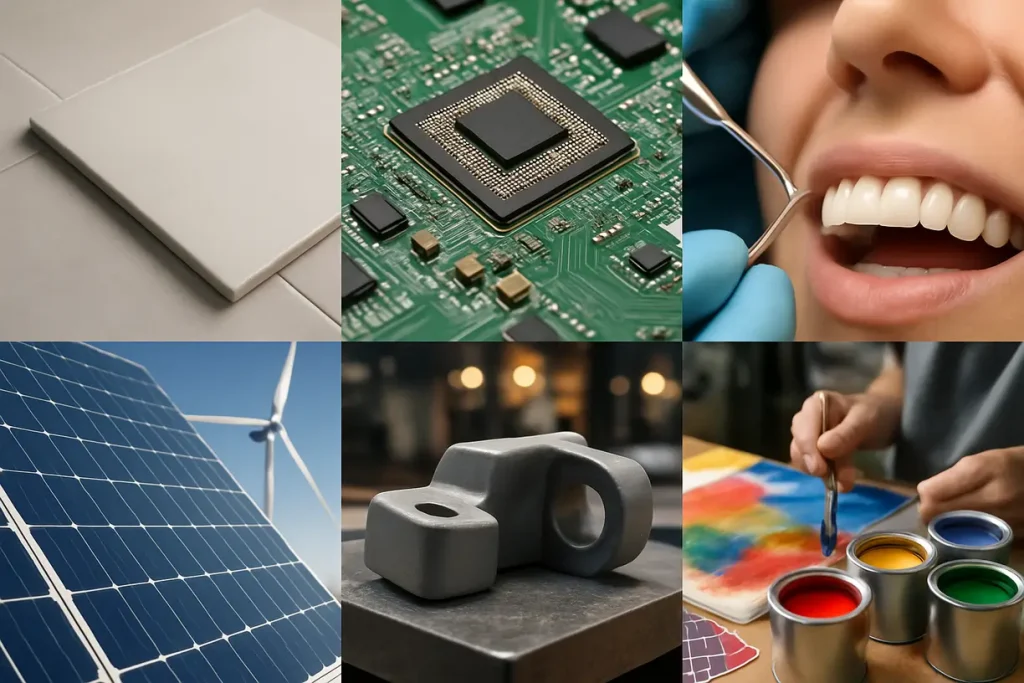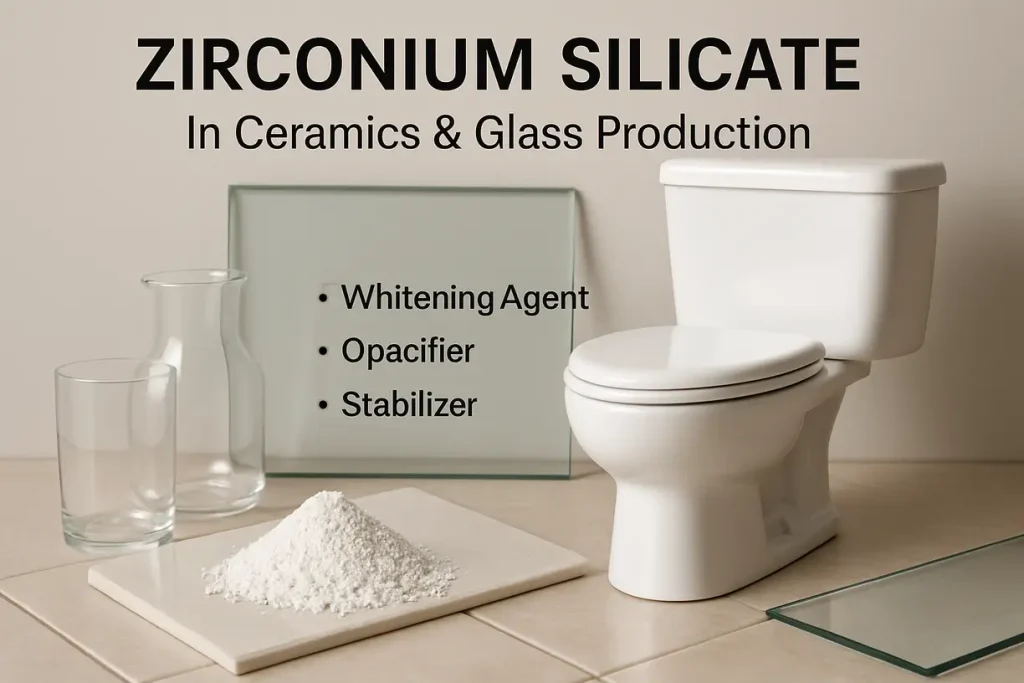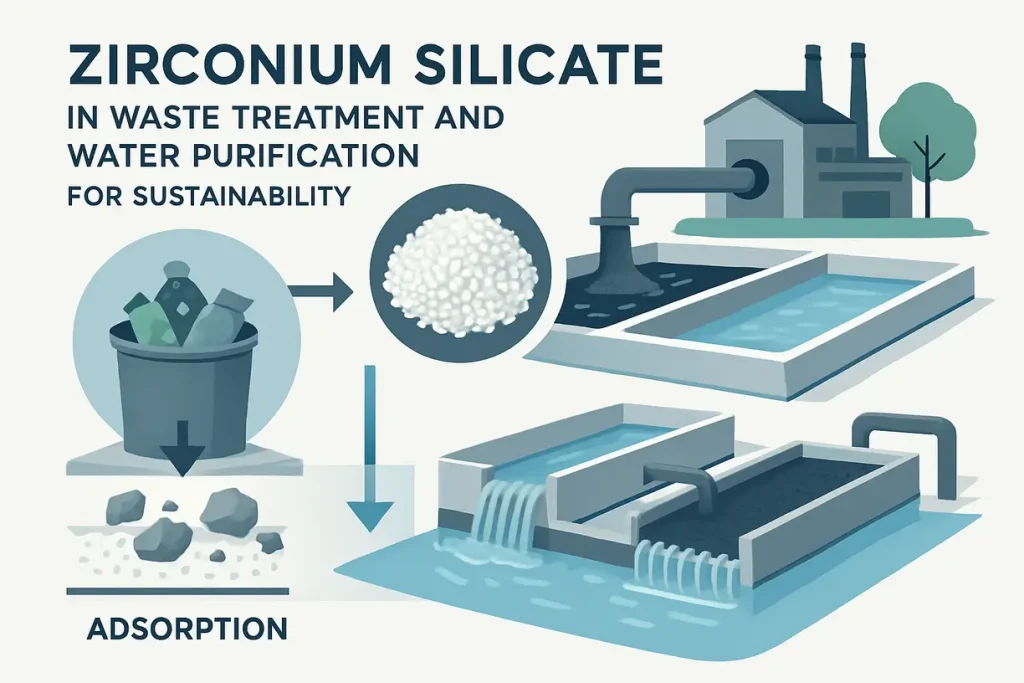In today’s competitive landscape, businesses constantly seek materials that can provide a unique edge. Zirconium silicate stands out, offering remarkable properties that could benefit multiple industries. However, many businesses may not fully understand where this versatile compound can be applied beyond its traditional uses. If your organization is exploring new avenues for this material, you’ve come to the right place. This article will guide you through various emerging industries that can effectively utilize zirconium silicate. With insights backed by credible research and comprehensive case studies, you will gain confidence in the broader applications of this valuable compound.
Zirconium silicate has been traditionally known for its role in ceramics and glass manufacturing. Still, it opens doors to innovative possibilities in sectors such as electronics, environmental technology, medicine, and construction. These advancements could revolutionize how products are developed and enhance their effectiveness. Modern challenges, such as sustainability and technological performance, further emphasize the need to explore new material options. Understanding where zirconium silicate fits into these industries can provide businesses with a significant competitive advantage.
Here’s the deal: As this material gains traction, businesses that adapt early can secure a first-mover advantage in markets by identifying applications that may not yet be widely recognized.

This image illustrates various industries utilizing zirconium silicate, showcasing its versatility and potential.
What New Industries Can Utilize Zirconium Silicate?
Zirconium silicate, a silicate mineral composed of zirconium and silica, is known for its exceptional properties, including high melting point, thermal stability, and chemical resistance. Its unique characteristics make it a prime candidate for various applications. However, many industries have not yet harnessed its full potential, leading to unexplored opportunities.
In sectors such as electronics, this compound can be utilized for advanced components due to its insulating properties and stability under thermal stress. Environmental technology can also benefit; as industries strive for more sustainable practices, integrating materials like zirconium silicate can enhance eco-friendly initiatives.
Moreover, its applications extend into medicine, where ongoing research is discovering its usefulness in making advanced healthcare products. In construction, those developing materials that require fire resistance and high durability can also benefit significantly.
Understanding the diverse applications of this material is crucial. For businesses, staying ahead means being aware of where these innovations can occur and leveraging them effectively.
Let’s break it down:
- Electronics: With the increasing need for efficient and reliable components, zirconium silicate can be instrumental in electronics manufacturing.
- Environmental Applications: The focus on sustainability in manufacturing processes can lead businesses to explore zirconium silicate as an alternative material.
- Medical Applications: Emerging research highlights new possibilities in the medical field, presenting opportunities to innovate and improve patient care.
- Construction Industries: Resilience in construction materials can significantly enhance building safety and longevity.
As industries evolve, recognizing the value of zirconium silicate solidifies its relevance and potential across multiple fields.
What Are the Current Applications of Zirconium Silicate?
Zirconium silicate has a wide range of applications in various industries. Most commonly, it is employed in the production of ceramics and glass, where its properties enhance durability and performance.
In ceramics, zirconium silicate not only improves the mechanical strength but also enhances thermal shock resistance. This is critical for high-performance applications where segments must withstand significant temperature variations without cracking or failing. Examples include ceramic tiles and dinnerware, both of which benefit from added durability and aesthetic appeal.
Moreover, several glass manufacturers utilize this material in their compositions. It adds clarity to glass products and contributes to overall durability. Its role is especially vital in the production of glass used in smart devices, where transparency and resistance to scratches are paramount. Furthermore, zirconium silicate plays a crucial role in refractory materials due to its high melting point and thermal stability. These materials are integral to industries such as metallurgy and steel production, where processes involve extremely high temperatures.

This image depicts the role of zirconium silicate in ceramics and glass production, highlighting its key applications.
Here’s a brief overview of its current applications:
| Application | Industry | Benefits |
|---|---|---|
| Ceramics | Ceramics and Tiles | Enhances strength and aesthetic |
| Glass | Glass Manufacturing | Improves clarity and durability |
| Refractory Materials | Metallurgy | Withstands high temperatures |
Possibly more critical is zirconium silicate’s increasing importance in high-tech applications that demand precision materials capable of maintaining integrity under harsh conditions. As such, engineers and product developers can tailor formulations to maximize efficiency and performance based on research findings.
So, let’s review: Zirconium silicate’s current applications showcase its versatility across industries, making it a vital component in modern manufacturing. By understanding and enhancing these applications, businesses can develop products that are innovative and meet the market’s evolving demands.
How Can Zirconium Silicate Benefit the Electronics Industry?
The electronics industry is rapidly evolving, with constant pressure to find materials that not only meet current demands but anticipate future needs. Zirconium silicate fits this bill perfectly.
Its excellent insulating properties make it ideal for applications in electronic devices, especially where efficiency and durability are crucial. For instance, when incorporated into dielectric materials, it enhances the efficiency of capacitors, leading to better performance in devices such as computers and smartphones. These devices are constantly required to operate at high capacities, and adding resilient materials can greatly improve longevity and reliability.
In addition, zirconium silicate’s ability to endure high temperatures and electrical stress makes it an attractive option in the production of insulators. This is crucial for ensuring that electronic components function properly in a variety of environmental conditions.
You might be wondering: What real-world examples demonstrate this application? Consider the production of high-performance capacitors used in smartphones. These capacitors benefit from enhanced durability provided by zirconium silicate, which translates to better reliability and energy efficiency.
To illustrate its benefits in more detail, here are specific advantages it brings to electronics:
| Benefit | Application | Value Added |
|---|---|---|
| High Insulating Capabilities | Dielectrics | Improved efficiency and performance |
| Temperature Resistance | Insulation | More reliable electronics for demanding applications |
| Enhanced Durability | Electronic Components | Longer life span for devices |
The efficiency and stability that zirconium silicate offers can lead to significant improvements in electronic device performance. As manufacturers seek to innovate further, integrating zirconium silicate may become standard practice.
In conclusion, as market demands push for smaller, faster, and more efficient devices, the role of zirconium silicate can be anticipated to grow, leading to a more capable and robust product development pipeline.
In What Ways Does Zirconium Silicate Apply to the Environmental Sector?
With increasing environmental concerns, the demand for sustainable materials and processes in various industries is on the rise. Zirconium silicate presents numerous benefits that can address these pressing demands and contribute to effective environmental solutions.
This compound has shown promise in waste treatment processes, where it can aid in encapsulating hazardous materials. Encapsulation is vital as it helps prevent toxic substances from leaching into the environment, thus protecting water and soil quality. Furthermore, its effectiveness in advanced water purification technologies is gaining attention. Zirconium silicate can be used in filtration systems, allowing contaminants to be removed efficiently, promoting public health and environmental sustainability.

The image demonstrates how zirconium silicate is utilized in waste treatment and water purification processes to enhance sustainability.
Here’s an interesting fact: Studies have highlighted its transformative potential in eco-friendly products, showcasing its role in sustainable practices. As manufacturers seek to reduce harmful emissions and waste, utilizing zirconium silicate can facilitate the development of green technologies.
The environmental benefits of this versatile compound can be summarized as follows:
| Application | Impact | Example |
|---|---|---|
| Waste Treatment | Reduces environmental impact | Encapsulation of heavy metals |
| Water Purification | Enhances water quality | Filtration systems for municipal water |
| Sustainable Products | Promotes eco-friendly manufacturing practices | Development of green chemicals |
By incorporating such materials, companies can position themselves as leaders in sustainability, attracting eco-conscious consumers and businesses.
Therefore, the incorporation of zirconium silicate not only promotes environmental responsibility but also enhances corporate image. As regulatory frameworks become more stringent, the need for integrating sustainable solutions will only grow stronger.
What Potential Does Zirconium Silicate Have in the Medical Field?
In the medical field, the desire for materials that offer biocompatibility, durability, and precision is paramount. Here, zirconium silicate is making inroads in ways that were once unimagined.
One of the most exciting areas of application is in dental materials. In this sector, zirconium silicate is employed to create prosthetics and crowns that closely mimic natural teeth. They not only achieve excellent aesthetics but also offer remarkable strength, making them suitable for everyday use. Additionally, ongoing research is investigating its use in advanced drug delivery systems. By fine-tuning its properties, medical researchers aim to utilize zirconium silicate to deliver medications more effectively and precisely, enhancing treatment outcomes.
Let’s look at some specifics: Zirconium silicate is also being researched for its potential in creating coatings that improve the biocompatibility of medical devices. These advancements could help minimize complications, ensuring greater patient safety and comfort.
The potential applications of this compound in medicine can be outlined as follows:
| Application | Benefit | Example |
|---|---|---|
| Dental Materials | Natural appearance and strength | Dental crowns and bridges |
| Drug Delivery Systems | Precise targeting of medications | Nanoparticles for targeted therapy |
| Medical Device Coatings | Enhances biocompatibility | Coatings for implants and prosthesis |
This expanding role in medicine highlights the material’s importance in enhancing patient care and fostering innovation.
As the medical field continues to advance, integrating zirconium silicate could lead to improved procedures and patient outcomes. Those in the healthcare sector who adopt these innovations can expect to see benefits not only for their practice but also for the communities they serve.
How Might the Construction Industry Utilize Zirconium Silicate?
In construction, the demand for resilient, reliable materials is ever-increasing. As the industry evolves, zirconium silicate emerges as a notable contender for various applications.
This material can significantly enhance products used in construction environments. For example, it is used in fireproofing applications, where its properties help create safer structures. Enhancing fire resistance is not just about compliance; it instills confidence in users regarding their safety.
Further, zirconium silicate can be incorporated into insulation materials. This helps improve energy efficiency in buildings, which is a growing concern for builders and consumers alike. Improved insulation not only lowers energy bills but also contributes to environmental sustainability by reducing emissions.
So here’s what you need to know: The benefits extend beyond basic fire protection. Zirconium silicate also aids in creating durable surfaces for flooring and wall tiling, providing not just functionality but aesthetic value as well.
To recap, its construction applications can be summarized:
| Application | Benefit | Example |
|---|---|---|
| Fireproofing | Enhances safety measures | Fire-resistant building materials |
| Insulation | Improves energy efficiency | Insulating panels and products |
| Surface Durability | Offers long-lasting aesthetics | Tiles and flooring solutions |
As construction approaches increasingly incorporate sustainable practices, zirconium silicate can play a key role in meeting regulatory standards while enhancing product performance. With a growing emphasis on building safer and more efficient structures, this compound becomes a valuable resource in modern construction efforts.

This image shows construction materials featuring zirconium silicate, highlighting its strength and durability in building applications.
What Innovations Are Emerging in Zirconium Silicate Research?
Research surrounding zirconium silicate continues to advance, with numerous innovations on the horizon that promise to broaden its applications.
Recent scientific studies focus on improving its material properties and exploring novel uses across various industries. For instance, researchers are developing new processing techniques to enhance its performance. This includes optimizing its chemical properties so that it performs exceptionally well in demanding conditions. Additionally, collaborations between universities and industry leaders ensure fresh ideas continually emerge. This can stimulate the development of materials that utilize zirconium silicate in innovative ways, encouraging businesses to experiment with it in their products.
Here’s the takeaway: Investing in research and development in this area not only reinforces existing applications but also cultivates new opportunities. As innovations unfold, adaptability will be key.
Recent developments and innovations in zirconium silicate research can be illustrated as follows:
| Innovation | Impact | Future Potential |
|---|---|---|
| Advanced Processing Techniques | Enhanced performance in various applications | Improved efficiency and sustainability |
| Collaboration Between Sectors | Broadens material applications | New product developments based on research |
| Biocompatibility Research | Opens doors for medical advancements | New medical applications including innovative therapies |
Staying abreast of research trends is essential for businesses seeking to remain competitive. As developments continue, those who recognize the potential of zirconium silicate will be better positioned to succeed.
How Do Market Trends Influence Zirconium Silicate Demand?
Understanding market trends is vital for companies looking to invest in materials like zirconium silicate effectively. The increasing demand for sustainable materials drives interest in this versatile compound.
With global trends pushing for reduced environmental impact, industries now regard materials that support sustainability highly. As regulatory frameworks evolve to enforce stringent standards, the use of eco-friendly materials becomes not just advisable, but essential. This shift opens up avenues for integrating zirconium silicate in more applications, promoting products that meet these new criteria.
Moreover, the rise of new technologies in electronics and medicine fuels exploration into this compound. Companies that adapt their practices in tandem with these trends will achieve long-term benefits, especially from an innovation standpoint.
Here are key trends impacting demand:
| Trend | Influence on Demand | Implications for Businesses |
|---|---|---|
| Sustainability Focus | Higher interest in eco-friendly materials | Growth in applications across multiple industries |
| Technology Advances | Demand for high-performance materials | Increased usage in electronics and medical fields |
| Regulatory Changes | New standards for materials | Need for businesses to adapt and innovate |
Staying attuned to market trends will guide organizations toward strategic decision-making. Consequently, those who embrace these changes will enjoy a competitive edge.
What Challenges Are Associated with Zirconium Silicate Usage?
While zirconium silicate presents numerous opportunities, it also comes with challenges that businesses must navigate to use it effectively.
One major hurdle is the technical limitations that can arise when integrating it into new applications. Achieving consistency in material properties can be difficult, which may impact performance. In some cases, achieving the desired qualities in end products can require significant adjustments in manufacturing processes.
Moreover, environmental regulations can complicate its usage in certain sectors, necessitating compliance with specific standards that can vary by region. Businesses must stay informed about these regulations and implement necessary changes to mitigate any risks associated with using zirconium silicate.
So here’s the key: Addressing these challenges head-on is essential for successful integration.
The challenges in utilizing this material may include:
| Challenge | Impact | Suggested Solutions |
|---|---|---|
| Technical Limitations | Affect performance consistency | Investment in research and development |
| Environmental Regulations | Limit application scope | Compliance with standards and sustainability practices |
| Market Competition | Challenges in positioning | Focus on unique selling propositions (USPs) |
Effectively navigating these challenges can lead to successful outcomes. Organizations demonstrating foresight in addressing potential issues will stand out in their respective markets. By putting measures in place that reduce risks and enhance rewards, companies can create a strong foundation for further exploration of this material.
Conclusion
In summary, zirconium silicate holds immense potential across various industries, from electronics to medical applications. Its unique properties offer significant benefits that can foster innovation and drive growth in these sectors. Early adoption of this compound can lead to superior competitiveness and enhanced sustainability, allowing organizations to thrive in a rapidly changing market. Global Industry encourages you to consider the integration of this valuable material into your processes. For more insights, connect with us to learn how we can help your organization navigate these changes and seize new opportunities as they arise.
FAQs
Q1: What is zirconium silicate used for? Zirconium silicate is primarily utilized in ceramics, glass manufacturing, and as a refractory material, offering high durability and resistance.
Q2: Can zirconium silicate be used in electronics? Yes, it is beneficial in electronics for insulators and dielectric applications, enhancing the performance of electronic components.
Q3: How does zirconium silicate impact the environment? This versatile compound can aid in waste treatment and water purification, promoting sustainable practices across industries.
Q4: Are there medical applications for zirconium silicate? Yes, it finds use in the medical field for dental materials and innovative drug delivery systems due to its favorable biocompatibility.
Q5: What are the challenges with zirconium silicate products? Challenges include technical limitations in production, navigating environmental regulations, and ongoing research needs to optimize its applications.
